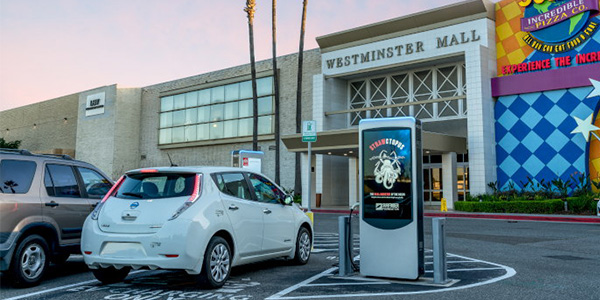FERC last week approved a CAISO Tariff change to increase demand response participation by businesses offering on-site electric vehicle charging and a second change to improve accounting for the load-shifting capabilities of behind-the-meter storage resources (ER20-2443).
The ISO pays DR resources when they curtail load during times of high demand for electricity and strained supply. But a growing share of DR resources now include on-site load, generating capacity and batteries. In particular, the ISO said, a growing trend is providing EV charging at large energy customer locations, such as grocery stores, theaters and office buildings.
“According to CAISO, EVSE [electric vehicle supply equipment] frequently operates under the same retail meter and account as their host facility,” FERC said. “Thus, the entire facility must participate as a single metered resource even though the EVSE and on-site host load may have very different load profiles. CAISO asserts that, by failing to capture the unique load profile of the EVSE, it may send the wrong price signals to EVSE owners, thereby failing to provide incentives to curtail load during peak conditions.”
CAISO also said storage and DR resources can play important roles in managing peak demand, especially during the evening ramp. The net peak after solar declines was a major source of problems for the ISO during its August and September energy emergencies. (See CAISO Provides More Details on Blackouts.)
The ISO said its current rules “only capture the value of reducing demand compared to typical use” and do not incentivize storage resources to increase demand during oversupply conditions, which it said would help maintain reliability, avoid curtailments and stabilize prices.
To fix those issues, CAISO proposed two Tariff modifications.
One would treat EVSE as a separate load curtailment measure when providing DR at facilities with on-site load.
“CAISO notes that it will not require such resources to separate their EVSE from the rest of their load, but, where demand response resources elect to measure EVSE performance separately, CAISO states that the resource must submeter the EVSE to avoid comingling the EVSE load and the on-site host load’s performance,” FERC said. “However, CAISO explains that the EVSE and on-site host load will still continue to operate under a single resource ID and will bid and meet CAISO schedules together as a single resource, but [they] will be settled separately based on their individual baselines.”
A second Tariff change creates “a demand response participation model to facilitate load-shifting capabilities of behind-the-meter energy storage resources to better account for when such resources charge or discharge at optimal times.” The change will establish two separate resource IDs: a consumption resource ID to track energy storage charging and a curtailment resource ID to account for the energy storage discharging to increase the site’s load curtailment.
Each resource ID will have its own baseline and DR energy measurement to establish typical use, using methodologies nearly identical to CAISO’s existing metering generator output methodology.
In comments, Southern California Edison supported the changes but worried they could lead to market gaming. CAISO said it was unpersuaded by SCE’s argument.
FERC accepted the revisions effective Oct. 1, saying they would improve DR participation.
“As CAISO explains, EVSE and behind-the-meter energy storage resources are increasing throughout the CAISO footprint at a rapid pace, and the goal of the proposed Tariff revisions is for CAISO’s policies to keep pace with these technological advancements.
“Allowing CAISO to implement these provisions will provide EVSE and behind-the-meter energy storage resources with access to CAISO’s wholesale markets under just and reasonable rules that will also capture their unique characteristics and benefits,” FERC said.



